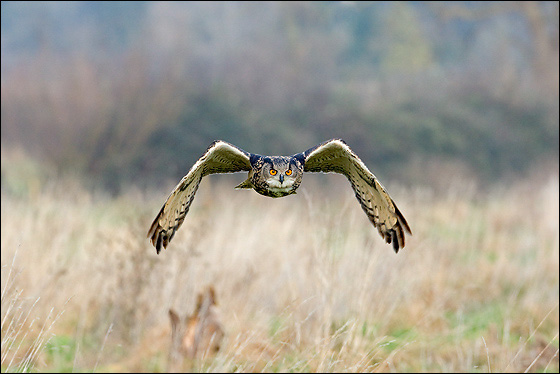Eagle Owl (Bubo bubo)
The Eagle Owl hunts in the fashion most common to owls, sitting out on perch and waiting for something edible to show itself. It will also use other techniques, though, too, especially a low searching flight which may flush prey into the open. Various unusual techniques reported, including catching birds in flight and walking over the ground are probably exceptional, but do indicate the versatility and adaptability of this supreme predator.
One off-the-wall feeding technique has, though, been recorded on a number of occasions perfectly reliably, and that is cannibalism. Young Eagle Owls hatch out at intervals of a day or so, leaving some chicks well behind the others in their development, and it is fairly common for these backmarkers to be eaten by their siblings, or even by their parents. More extraordinary still, it is known for adult Eagle Owls to be killed by their own kind as well.
The Eagle Owl is primarily a nocturnal species, beginning to become active after sunset. Birds mainly hunt within a home range that they occupy all year, and know the best sites to look for food. Their private area is usually between 12 and 20 km² in extent, but when the male and, later the female are seeking food for the young, the birds tend to remain within a kilometre or so of the nest site. Eagle Owls defend their territory by giving a deep and somewhat authoritative hoot, in keeping with their stature, but they also make a wide range of other sounds.
The pair starts breeding very early in the year, often having eggs in the nest in February even in Scandinavia. Fore breeding the birds use all sorts of different sites, but rocky ledges and cave entrances are probably the favourites, with tree holes and abandoned open nests as alternatives. At the nest they are, despite being formidable birds, extremely sensitive to human disturbance, and have been known to abandon quite well grown young when subject to intrusion.
The Eagle Owl is often quoted as being highly intolerant of man, retreating to wilderness areas as settlement advances. It is certainly quick to depart when persecuted, but when left alone it can do surprisingly well in the face of neutral human activity, taking advantage of man’s creations such as clear-fells and rat infested rubbish dumps. After recent fears about it future in Europe, the Eagle Owl has proven more resilient than we expected.

